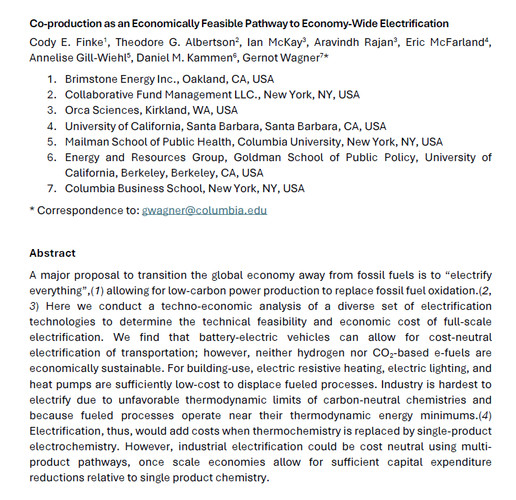Private-sector progress accelerates
New carbon removal funds show the private sector is stepping up on climate, and that’s reason for optimism.

It’s been 50 days since Russia’s unprovoked attack on Ukraine. A lot has changed since then, but viewed from a different angle, very little has. Russia now faces some of the stiffest sanctions ever devised — with major carveouts for oil, gas, and coal. The U.S. has banned the import of Russian oil, although it never imported a lot to begin with. The European Union, meanwhile, has bought from Russia some $35 billion worth of fossil fuels and counting since the invasion.
It’s easy to get despondent: another crisis, another missed opportunity. Looking back, many of the European policy responses — or lack thereof — could best be explained by EU politicians thinking that Kyiv would fall quickly. It would all be over soon, and we could go back to regularly scheduled programming.
Kyiv didn’t fall.
Call me hopelessly optimistic, but something is different. The longer this war of choice waged by Russian President Vladimir Putin has dragged on, the clearer it has become that the current situation is untenable. Nobody questions if things must change, just when and how. The differences in energy and outlook seem palpable to me. Perhaps it is a function of my spending the spring semester at a business graduate program instead of a policy school.
The way that many business leaders speak about the “threat” of climate policy can be jarring. It took me a while to get used to the fact that, in this world, “climate risk” primarily refers to the effects of climate policy on the bottom line, rather than those of climate change on lives and communities. But even in that there is good news: Most business leaders expect climate policy to go in one and only one direction (even if some try to delay action as long as possible, causing untold damage in the process). It’s also good news that a growing number of countries and businesses have committed to achieving net-zero emissions, and that those pledges add up to limiting the increase in global average temperatures, if they’re acted upon.
Cue the inevitable jokes about distant promises: “Man announces he will quit drinking by 2050.” Skepticism is healthy. But so is seeing the enthusiasm among the next generation of private-sector leaders to be part of the solution.
Every time a student has walked into my office at Columbia Business School this spring (or signed up for a 6 a.m. morning run with their professor), it is with a proposal to fix one or another piece of the puzzle. There’s the student with deep knowledge of commercial real estate who identified a gap in shifting the building sector to clean energy. His mission: to start a fund that closes that gap. The student with a fine arts background and sales experience at an auction house? She wants to put that background to work in the energy transition. The goal of the Nigerian student who’s a chemical engineer and former consultant in the oil and gas sector? Help transform that industry.
Some of the transformation begins with business schools themselves. The three students who walked into my office on Wednesday with an “Open Letter on Climate Action at Columbia Business School” collected more than 200 signatures among fellow MBA students that same afternoon. The two climate-focused classes now taught at the school are woefully oversubscribed.
My own class this week was focused on offsets. Mere mention of offsets often invokes images of a broken system that lets polluters off the hook. Keep burning fossil fuels, Russian or otherwise, while finding the cheapest possible way to be able to put a tree on the annual report: Is that really the best we can do? The focus of our three-hour discussion was on getting offsets right. It helped that Nan Ransohoff, head of climate at Stripe Inc., dropped by for a discussion, the day after the company announced a new $925 million fund — paid into by the likes of Alphabet Inc. and McKinsey & Co. Inc. — to jumpstart the market for carbon removal technologies.
The students’ most biting question was around the fund’s exit strategy: “It’s mostly philanthropy, right?” Yes and no. That’s where policy comes in. It is also what another venture hopes to address, a $350 million fund announced yesterday and raised by LowerCarbon Capital, a firm founded four years ago by Chris and Crystal Sacca. Its goal is to help carbon removal startups and make money doing so.
Even investments on that scale will not “solve” climate change. Both Stripe and LowerCarbon Capital are clear about that. It will take trillions, most spent on scaling existing, already cheap technologies like building insolation, heat pumps, and solar and wind generation, all of which more than pay for themselves. There, too, is lots of excitement, showing business in the lead, with reactionary politicians grasping at ever smaller straws to try to delay the inevitable.
Action is still much too slow. Ask any climate scientist, or Ukrainian President Volodymyr Zelenskiy. Getting the world off fossil fuels must be a much bigger priority than it is now. And business leadership can’t replace policy, which is essential. But it does help transform climate policy from a risk into an opportunity.
Gernot Wagner writes the Risky Climate column for Bloomberg Green. He teaches at Columbia Business School (on leave from New York University). His latest book is Geoengineering: the Gamble (Polity, 2021). Follow him on Twitter: @GernotWagner. This column was first published by Bloomberg Green on April 15th, 2022, under the title "Business Leaders Know the Climate Status Quo Is Untenable," and does not necessarily reflect the opinion of Bloomberg LP and its owners.


